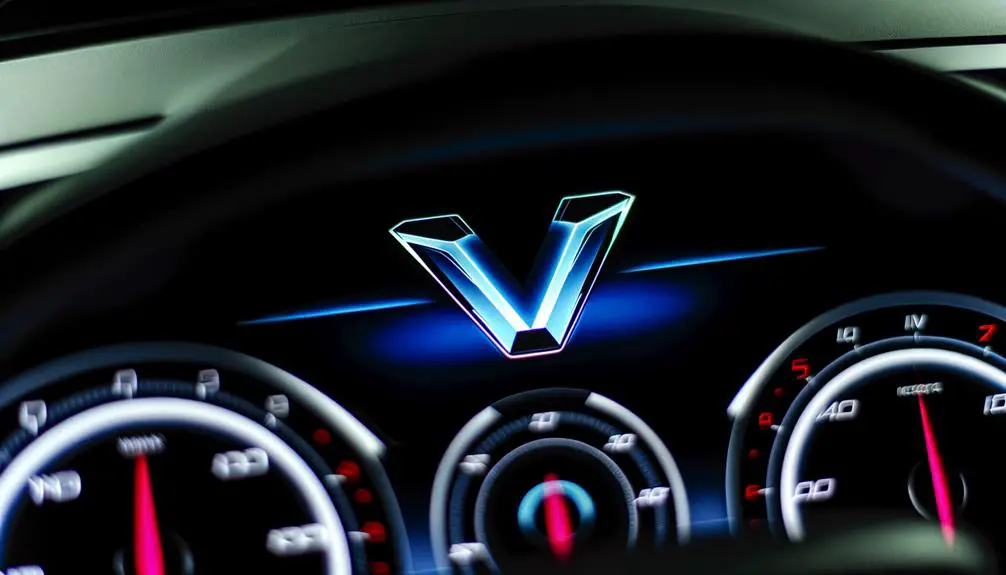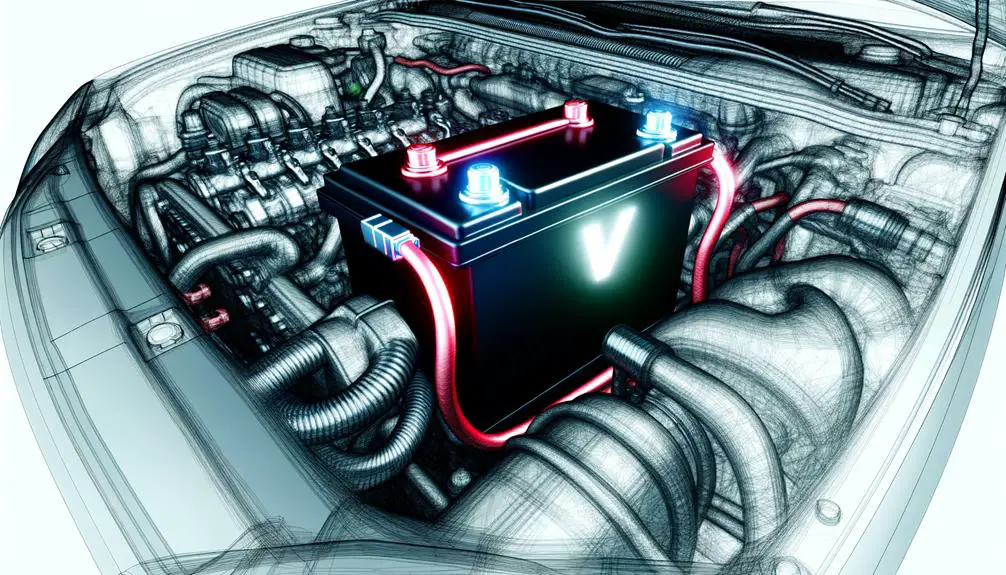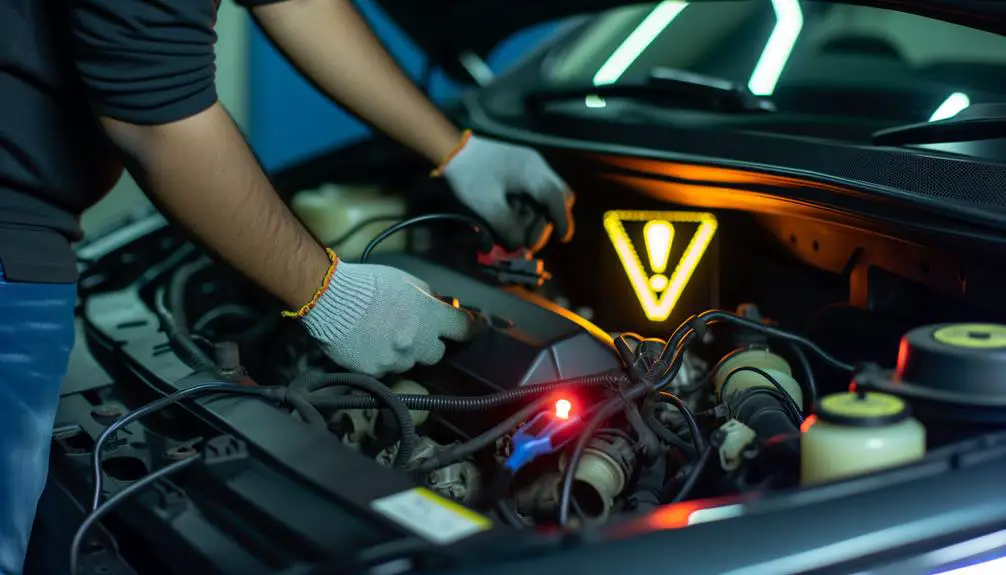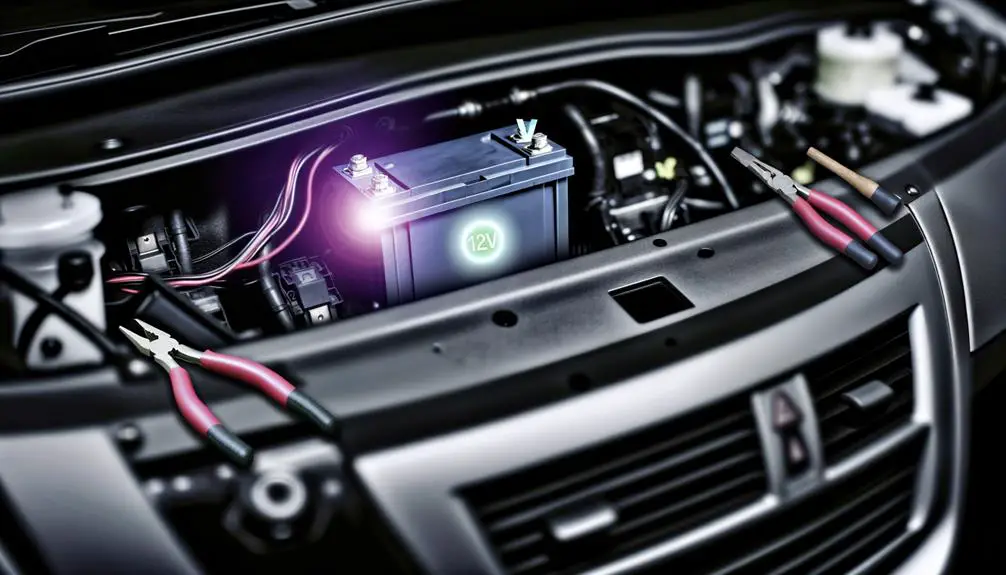What Does the 12V Symbol Mean in a Car?
The 12V symbol in a car denotes the presence and functionality of its 12-volt battery system. This battery is essential for starting the engine and powers various electrical components, including lighting systems, infotainment units, and Electronic Control Units (ECUs).
It guarantees the car's clock, computer, and security systems remain operational even when the engine is off. Proper maintenance involves inspecting battery terminals, checking voltage levels with a multimeter, and confirming the alternator functions correctly.
Understanding how the 12V battery contributes to your vehicle's performance and reliability can provide deeper insights into its critical role.

Key Takeaways
- The 12V symbol indicates the car's 12-volt electrical system.
- It signifies the battery's role in starting the engine and powering electronics.
- The symbol often appears on battery-related warning lights.
- A 12V warning light suggests battery or alternator issues.
- Check the 12V system for proper voltage and connections if the symbol appears.
The Role of the 12V Battery

The 12V battery in a car serves as a crucial power source for starting the engine and operating electrical systems when the engine is not running. It provides the necessary electrical current to the starter motor, which then initiates the engine's combustion process.
Additionally, the 12V battery maintains essential functions such as powering the vehicle's computer, clock, and security system when the ignition is off. Constructed from lead-acid cells, the battery converts chemical energy into electrical energy, enabling reliable performance under various conditions.
Proper maintenance and monitoring of the 12V battery are essential to guarantee longevity and prevent unexpected failures, which can lead to significant inconvenience and potential safety hazards for the vehicle owner.
Components Powered by 12V
Many critical components within a car rely on the 12V battery to function effectively, including the lighting system, infotainment system, and electronic control units. The 12V battery serves as the primary power source for various essential subsystems, ensuring operational efficiency and vehicle reliability. Below is a table outlining key 12V-powered components and their roles:
| Component | Function | Importance |
|---|---|---|
| Lighting System | Provides illumination for visibility and signaling | Safety and compliance |
| Infotainment System | Delivers entertainment and navigation functionalities | Driver convenience and experience |
| Electronic Control Units | Manages engine, transmission, and other car functions | Performance and efficiency |
| Power Windows | Enables automatic opening and closing of windows | Comfort and ease of use |
Understanding these components underscores the importance of a well-maintained 12V battery.
Diagnosing Electrical Issues

Diagnosing electrical issues in a vehicle requires a systematic approach to identify and resolve potential malfunctions within the 12V-powered systems. Begin by using a digital multimeter to measure voltage levels at various points of the electrical circuit, making sure that the battery voltage is within the optimal range of 12.4 to 12.7 volts when the engine is off.
Inspect all fuses for continuity and examine connectors for corrosion or loose connections. Evaluate the alternator's performance by checking the charging voltage, ideally between 13.8 to 14.4 volts when the engine is running. Assess the condition of the wiring harness for any signs of wear or damage.
Following these diagnostic steps guarantees accurate identification and rectification of electrical issues.
Maintaining Your 12V System
Regularly inspecting and servicing the 12V system enhances performance and longevity of the vehicle's electrical components. Begin by routinely checking the battery terminals for corrosion and ensuring secure connections.
Utilize a multimeter to measure voltage levels, verifying that readings fall between 12.4V to 12.7V when the engine is off. Inspect the alternator for proper function, ensuring it maintains the battery charge during operation.
Examine fuses and relays for signs of wear or damage, replacing any faulty components immediately. Pay attention to wiring integrity, looking for frayed or exposed wires that could lead to short circuits.
Upgrading the 12V Battery

When considering an upgrade to your vehicle's 12V battery, it is crucial to evaluate the battery's capacity, compatibility with your vehicle's electrical system, and the specific power requirements of any additional aftermarket accessories you may have installed.
Begin by determining the appropriate amp-hour (Ah) rating to guarantee sufficient energy storage. Verify that the battery dimensions fit within the designated compartment and that terminal types match your vehicle's connections.
Consider advanced battery technologies, such as AGM or lithium-ion, which offer superior performance and longevity compared to traditional lead-acid batteries. Additionally, assess the charging system's capability to handle the new battery's specifications.
Securing these factors align will optimize performance and reliability, preventing electrical system issues and enhancing overall vehicle functionality.
Conclusion
The complex dance of the 12V system in vehicles underscores its central role akin to a conductor orchestrating a symphony. This system powers necessary components, demands careful maintenance, and requires precise diagnostics.
Upgrading the 12V battery, akin to improving an instrument, guarantees peak performance. Therefore, comprehending and preserving this electrical linchpin is essential for vehicular reliability and longevity, echoing the timeless adage that a well-tuned mechanism operates harmoniously.





